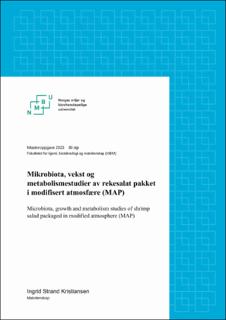| dc.contributor.advisor | Hilde M. Østlie | |
| dc.contributor.advisor | Davide Porcellato | |
| dc.contributor.author | Kristiansen, Ingrid Strand | |
| dc.date.accessioned | 2023-08-19T16:27:09Z | |
| dc.date.available | 2023-08-19T16:27:09Z | |
| dc.date.issued | 2023 | |
| dc.identifier | no.nmbu:wiseflow:6839567:54592194 | |
| dc.identifier.uri | https://hdl.handle.net/11250/3084911 | |
| dc.description.abstract | Maten vi spiser er sjeldent steril og kan inneholde mikroorganismer som finnes naturlig i råvarene, eller ved at de tilføres under bearbeiding og produksjon. I noen tilfeller kan mikroorganismer føre til dårlig kvalitet i form av lukt og smak, forråtnelse og i noen tilfeller sykdom. Mat er et godt egnet vekstmedium for mikroorganismer, hvor indre faktorer som pH, vannaktivitet og tilsetningsstoffer påvirker vekst av mikroorganismer. Blant ytre faktorer er temperatur og atmosfære viktige og bestemmer i stor grad hvilke mikroorganismer som kan vokse. Vanlige Gram-negative kvalitetsforringende bakterier i kjølelagret mat inkluderer Pseudomonas spp. og Photobacterium spp., mens Gram-positive kvalitetsforringende bakterier i modifisert atmosfærepakket mat kan være ulike melkesyrebakterier (MSB). Melkesyrebakterier er naturlig tilstede i fermenterte produkter og produserer hovedsakelig melkesyre ved fermentering av karbohydrater. I produkter hvor disse karakteristikaene ikke er ønsket kan det føre til en uakseptabel endring av produktet.
I denne studien ble en norskprodusert modifisert atmosfærepakket rekesalat og ingrediensene fra tre ulike produksjoner analysert og sammenlignet gjennom holdbarhetstiden. Prøvene ble analysert for celletall, karbohydrater og organiske syrer (HPLC), pH og identifisering av isolat ved Sanger sekvensering og mikrobielle samfunn ved bruk av Illumina sekvensering. Resultatet viste at det var forskjell i den mikrobielle sammensetningen i rekesalat fra de tre produksjonene. Spesielt produksjon 2 og 3 hadde en høyere vekst av MSB, og en dominans av Pediococcus parvulus gjennom holdbarhetstiden. Produksjon 1 hadde derimot en dominans av Periweissella fabalis/ghanensis, men Ped. parvulus var også tilstede.
Metabolismeforsøket ved bruk av HPLC og måling av pH viste forskjeller i omsetning av karbohydrater og produksjon av organiske syrer. Produksjon 2 og 3 hadde høyest innhold av maltose ved uke 0 og høyest produksjon av melkesyre med ca. 2700 ppm og 3000 ppm ved uke 7. Dette førte til en nedgang i pH i produksjon 2 og 3 fra ca. pH 4,8 og 4,7 til pH 4,4 og 4,2 mot slutten av holdbarhetstiden. Produksjon 1 hadde høyere innhold av glukose og fruktose i uke 0, men en lavere omsetning og dermed mindre produksjon av melkesyre (fra ca. 250 ppm i uke 0 til ca. 750 ppm i uke 7) som resulterte i at pH lå i området pH 4,8 og 4,7 gjennom hele holdbarhetstiden.
Resultatet fra denne studien tyder på at produksjon av melkesyre i rekesalat i stor grad påvirkes av tilgjengelig substrat i kombinasjon med hvilke mikroorganismer som dominerer. Hvilke mikroorganismer som er tilstede i ingrediensene, samt hvilke karbohydrater de bidrar med vil dermed sannsynligvis ha stor betydning for veksten av bakterier i ferdig produkt. | |
| dc.description.abstract | The food we consume is rarely sterile and may contain microorganisms that occur naturally in the raw materials or are introduced during processing and production. In some cases, these microorganisms can lead to poor quality such as of bad odour and taste, spoilage, and even illness. Food is a suitable growth medium for microorganisms, where intrinsic factors such as pH, water activity and additives affect the growth of microorganisms. Among extrinsic factors, temperature and atmosphere are essential and they largely determine which microorganisms that may grow. Common Gram-negative spoilage bacteria in cold stored food include Pseudomonas spp. and Photobacterium spp., while Gram-positive spoilage bacteria in modified atmosphere packaged food include various lactic acid bacteria (LAB). Lactic acid bacteria are naturally present in fermented food products and produce lactic acid by fermentation of carbohydrates. In products where these characteristics are not desired, these bacteria can lead to unacceptable changes in the food.
In this study, a Norwegian-produced modified atmosphere packaged shrimp salad and the ingredients from three different productions were analysed and compared through their shelf life. The samples were analysed for cell count, carbohydrates and organic acids (HPLC), pH, identification of isolates by Sanger sequencing, and microbial communities using Illumina sequencing. The results showed that there were differences in the microbial composition of shrimp salat from the three productions. Specifically, production 2 and 3 had a higher growth of LAB and a dominance of Pediococcus parvulus throughout the shelf life. For production 1, on the other hand, Periweissella fabalis/ghanensis was the dominant bacteria, however Ped. parvulus was also present.
By investigating the metabolism using HPLC and pH, the analysis showed a difference in the metabolism of carbohydrates and the production of organic acids. Production 2 and 3 had the highest content of maltose and the highest production of lactic acid of approximately 2700 ppm and 3000 ppm at week 7. This led to a lower pH in production 2 and 3 from approx. pH 4,8 and 4,7 to pH 4,4 and 4,2 towards the end of their shelf life. Production 1 had a higher content of glucose and fructose at week 0, but a lower metabolization of carbohydrates and thus, less production of lactic acid (from 250 ppm in week 0 to 750 ppm in week 7), resulting in a pH around 4,8 and 4,7 throughout the entire shelf life.
The results of this study suggest that the production of lactic acid in shrimp salad is largely influenced by the substrates available in combination with the dominating microorganisms. Therefore, the microorganisms that are present in the ingredients, as well as the carbohydrates they contribute, will likely have a significant impact on the growth of bacteria in the final product. | |
| dc.language | nob | |
| dc.publisher | Norwegian University of Life Sciences | |
| dc.title | Mikrobiota, vekst og metabolismestudier av rekesalat pakket i modifisert atmosfære (MAP) | |
| dc.type | Master thesis | |
